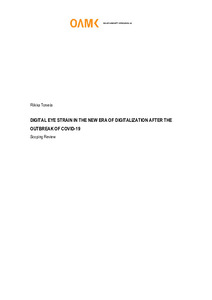Digital Eye Strain in the New Era of Digitalization after the Outbreak of COVID-19: Scoping Review
Torvela, Riikka (2022)
Torvela, Riikka
2022
All rights reserved. This publication is copyrighted. You may download, display and print it for Your own personal use. Commercial use is prohibited.
Julkaisun pysyvä osoite on
https://urn.fi/URN:NBN:fi:amk-2022100420834
https://urn.fi/URN:NBN:fi:amk-2022100420834
Tiivistelmä
Introduction: The outbreak of COVID-19 led the world to a new era of digitalization, as the mandatory worldwide social isolation in the first quarter of the year 2020 changed the communication between people to happen mainly through digital platforms. It is to be expected that due to time and money-saving aspects, remote working and studying will continue after the worse days of the pandemic, and hours of digital device usage will also remain massive in the future.
Purpose: This scoping review aimed to identify existing research results and possible information deficiencies in the existing studies and compare empirical evidence of how the outbreak of COVID-19 has impacted the use of digital devices and, thereby, digital eye strain in adults.
Methods: This scoping review consisted of eight qualitative descriptive survey studies. The main literature search was conducted on the 21st of March 2022 from three different databases, PubMed, CINAHL, and Academic search premier, using key search terms ("computer vision syndrome" OR "digital eye strain") AND ("covid-19" OR "sars-cov-2"). Only studies regarding adults (age limit 18 years), available in full text and published in English, were included.
Results: The reported average increase in screen time after the outbreak of COVID-19 ranged between 2.1h – 4.8h ± 2.8h, raising the total screen time to 8.65h ± 3,74h - 11.1h ± 4.5h. The prevalence of digital eye strain ranged between 66.6% to 94.3%. The increase in screen time was the most reported risk factor for DES. Young adults were found to be more symptomatic than relatively older people. Even though the prevalence of DES remained quite the same compared to pre-covid time, the frequency and intensity of symptoms became more severe while total screen time increased in all age groups. Additionally, the median DES scores were higher for those whose screen time jumped more during the pandemic. The most common symptoms were headache, dryness of the eyes, eye strain, and eye fatigue.
Conclusions: The results give an alarming sign of how this new era of digitalization may lead to epidemic worsening or even chronic state of digital eye strain in the future, especially among young adults, all students, and remote workers, if total screen time remains as high as reported in recent studies, adequate breaks are not taken care of, and proper ergonomics are neglected.
Purpose: This scoping review aimed to identify existing research results and possible information deficiencies in the existing studies and compare empirical evidence of how the outbreak of COVID-19 has impacted the use of digital devices and, thereby, digital eye strain in adults.
Methods: This scoping review consisted of eight qualitative descriptive survey studies. The main literature search was conducted on the 21st of March 2022 from three different databases, PubMed, CINAHL, and Academic search premier, using key search terms ("computer vision syndrome" OR "digital eye strain") AND ("covid-19" OR "sars-cov-2"). Only studies regarding adults (age limit 18 years), available in full text and published in English, were included.
Results: The reported average increase in screen time after the outbreak of COVID-19 ranged between 2.1h – 4.8h ± 2.8h, raising the total screen time to 8.65h ± 3,74h - 11.1h ± 4.5h. The prevalence of digital eye strain ranged between 66.6% to 94.3%. The increase in screen time was the most reported risk factor for DES. Young adults were found to be more symptomatic than relatively older people. Even though the prevalence of DES remained quite the same compared to pre-covid time, the frequency and intensity of symptoms became more severe while total screen time increased in all age groups. Additionally, the median DES scores were higher for those whose screen time jumped more during the pandemic. The most common symptoms were headache, dryness of the eyes, eye strain, and eye fatigue.
Conclusions: The results give an alarming sign of how this new era of digitalization may lead to epidemic worsening or even chronic state of digital eye strain in the future, especially among young adults, all students, and remote workers, if total screen time remains as high as reported in recent studies, adequate breaks are not taken care of, and proper ergonomics are neglected.
